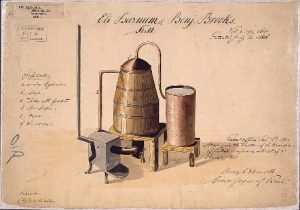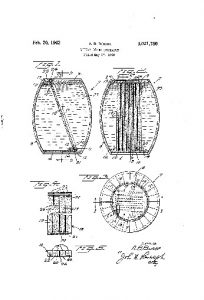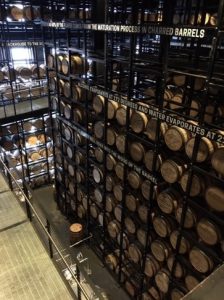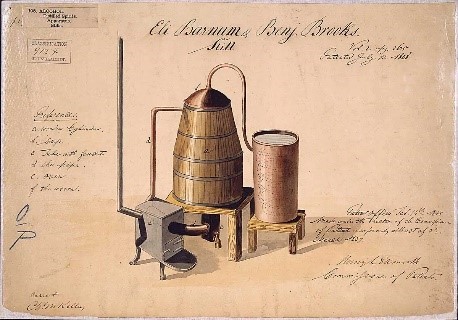How has patent law affected the bourbon industry? Faced with ample free time as a result of the stay-at-home order during the COVID-19 pandemic, this thought popped into my head while I was reminiscing about my past vacation to Kentucky’s renowned Bourbon Trail.
A Shot of Bourbon
Bourbon has historically played a large part of America’s cultural identity. Like many spirits, it is generally made by fermenting grains, distilling the fermented product, and then maturing the distillate. Bourbon content is tightly regulated by federally legislated standards. It must contain no less than 51% corn, it cannot exceed 160 proof off of the still, and it may not be aged at more than 125 proof in new charred oak barrels. Congress even designated bourbon as a distinctive product of the United States in 1964. With distilling being such a large part of American life, it is no surprise distillers wanted to maximize their profits with patent protection.
A Distilled Lesson on Patents
Patents are a form of intellectual property. A patent owner has the right to exclude others from “making, using, offering for sale, or selling the invention throughout the United States or importing the invention into the United States.” The right generally lasts for 20 years from the time the patent application is filed, but does not begin until the patent issues. One justification for granting this limited monopoly is to reward the inventor for disclosing something useful to society. Furthermore, this reward may incentivize inventors.
The U.S. Constitution grants the federal government the power to issue patents via the “IP clause.” The federal government issues patents to achieve the clause’s goal of “promot[ing] the progess of science.” In the U.S., the United States Patent and Trademark Office (USPTO) examines patent applications for usefulness, novelty, and nonobviousness amongst other statutorily mandated requirements to issue a patent. Certain things are barred from being patented, such as natural phenomena, laws of nature, and abstract ideas.
Mix One Part Bourbon with a Splash of Patents
Patents have played a role in developing the American bourbon industry. There are bourbon patents on the distillation method, the aging process, and the storage process.
Add Heat

Early American distillers used pot stills such as Eli Barnum’s and Benjamin Brooks’ patented still. The process generally worked by heating the fermented liquid in the pot until the alcohol vaporized. The vapor would rise through a condenser where it would cool and condense back into a liquid. This liquid would then be collected in a separate pot. Depending on the distiller’s preference, this process would be repeated until a preferable flavor and/or purity was achieved. Aeneas Coffey revolutionized the process in 1831 with his invention of a continuous column still known as the “Coffey Still” or “Patent Still.” It essentially worked like a series of single pot stills, utilizing two vertical tubes (the analyzer and the rectifier). Inside the analyzer, fermented liquid would be boiled and the alcoholic vapors would travel through different layers of porous plates until it entered the rectifier. Once in the rectifier, the vapor would continue to rise until it reached the top, where it would condense and be collected.
Once the U.S. recovered from the Civil War, American inventors began to put their own spins on the column still. Dierykx’s “Alcohol Still” patent issued in 1880 (Pat. No. 228,449). This still introduced the fermented liquid into the column though a coil that ran from the top of the column to the bottom. This allowed to liquid to be heated continuously before it reached the base. Another example included Jett’s 1909 patent, “Whisky Still” (Pat. No. 908,465), which utilized a single column with an agitator to keep solids from burning in the still.
Let Sit for at least Two Years

Aging is just as important as distilling when making bourbon. According to 27 CFR § 5.22, bourbon must be aged in a new charred oak container. In order for it to be designated as a “straight bourbon whiskey,” it must have aged in the barrel for at least two years. During this aging process the distilled liquid interacts with the charred wood from the barrel, giving the bourbon its color and flavor. While aging bourbon may be an unpatentable natural phenomenon, inventions aiding the aging process are patentable. In 1892, G.H. Forster received a patent (Pat. No. 481,350) on a barrel with a grooved/textured inside to increase the surface area of wood for the whiskey to interact with. Furthermore, in 1909, A.B. Bobbe patented (Pat. No. 3,021,780) a barrel with removable charred oak inserts so the barrel itself remained uncharred and reusable.

The storage method is as important to aging as the barrell is. Most bourbon barrels are stored in rickhouses. These are warehouses without climate control where barrels are stored in “ricks,” or racks. The lack of climate control allows the fluctuating outside temperatures to dictate how the barrel expands and contracts with the whiskey. The more the wood expands and contracts, the more it interacts with the whiskey, imparting color and flavor. In 1879, Frederick Stitzel (Pat. No. 9,175) patented a tiered storage system for barrels. This simple invention provided two benefits. First, distillers could stack barrels on racks to greater heights without worrying about crushing the bottom barrels. Second, because distillers could stack the barrels higher, they could take advantage of larger temperature swings associated with higher elevations.
Final Notes: Oaky with a Hint of Photochemistry…
Some distillers today are trying to create spirits that taste like aged whiskey without having to wait years for it to sit in a barrel. Lost Spirits Technology received a patent in 2017 (Pat. No. 9,637,712) on a process that can chemically age spirits 20 years in 1 week. Basically, it subjects an unmatured spirit to cycles of heat and light-driven chemical reactions involving pieces of oak barrels. These reactions increase the concentration of chemical compounds that would otherwise be present through natural aging. Despite not currently having a bourbon flavored product in the market, such a product would not be allowed to be classified as bourbon (because it would not meet all of the statutory requirements).
While this science experiment sounds intriguing, many distillers continue to use the tried-and-true patented technology of the past to make bourbon. Lucky for them, most of these prior patents are expired and available to be freely used by anyone. Therefore, let’s raise a glass to bourbon, to patents, and to health. Cheers!

Damyan Kolomayets
Senior Editor
Loyola University Chicago School of Law, J.D. 2021
Damyan is a rising 3L who is intrigued with how patent law intertwines with everyday life.
